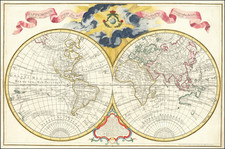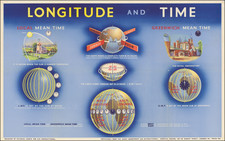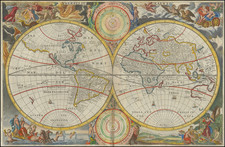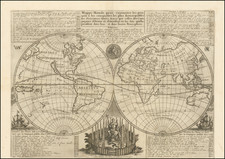Fine representation of the Cardinal Borgia map of the World from the 15th Century.
The map is believed to have been made sometime between 1410 and 1450. The map was discovered in the late 18th Century in an antique shop and thereafter became a part of the collection of Cardinal Stefano Borgia in a shop in Portugal. It currently resides in the Vatican. The map is engraved on two copper plates riveted together to form a circle, 24 inches in diameter, with color rubbed in the engraved channels (nielli).
The map is interesting for a number of reasons, including its non-Ptolemaic origins. The Garden of Eden is positioned near India superior, the mouth of the Ganges, and is portrayed as a land of marvels and precious stones. It is also quite close to China, a country which is represented by tiny figures collecting silk from the trees. The Babylonian, Alexandrian, Carthaginian and Roman Empires are emphasized on the map. On Italy, the mapmaker comments that "Italy, beautiful, fertile, strong and proud, from lack of a single lord, has no justice". Special mentions are made of various Crusades including: Charlemagne's campaign in Spain; crusading in northeastern Europe, Africa, and Nicropolis; and the "future" threat of the Gog and Magog, who are described specifically as "Jews". The map has a well crafted design, and was made to last a long time.
The section at the bottom of this example is an enlargement of a scene in the lower center of the map.
The Borgia map includes a legend referring to Ebinichibel, who is described as "the Saracen Ethiopian king with his dog-haired people, an example of the blasphemous extremes of the world being depicted as monstrous races. For a more complete description of the map, see here: cartographic-images.net/Cartographic_Images/237_The_Borgia_World_Map.html
The map appeared in Histoire de L'Art Par Les Monumens. Tome Quatrieme . . . . , only 30 years after its initial discovery.
Jean Baptiste Louis George Seroux D'Agincourt (1730-1814) was a French archaeologist and historian.
Born at Beauvais, he was a descendant of the counts of Namur, and in his youth served as an officer in a regiment of cavalry. Finding it necessary to quit the army in order to take charge of his younger brothers who had been left orphans, he was appointed a farmer-general by Louis XV. In 1777, he visited England, Germany and the Dutch Republic; and in the following year he travelled through Italy, with the view of exploring thoroughly the remains of ancient art. He afterwards settled at Rome, and devoted himself to preparing the results of his researches for publication.
He died in 1814, leaving the work, which was being issued in parts, unfinished; but it was carried on by M. Gence, and published complete under the title L'Histoire de l'Art par les monuments, depuis sa décadence au quatrième siècle jusqu'à son renouvellement au seizième (6 vols. fol. with 325 plates, Paris, 1823). In the year of his death D'Agincourt published in Paris a Recueil de fragments de sculpture antique, en terre cuite.









![Geografia sistematica d'Eratostene. [Geography of Eratosthenes]](https://storage.googleapis.com/raremaps/img/small/89132.jpg)




